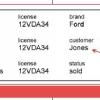 |
Increase Quality with Table-Driven Acceptance Tests Vague or ambiguous requirements can cause loops in development processes. Creating requirements that include acceptance tests cuts down on the looping and increases the flow of working software to the customer.
|
|
 |
Action Based Testing For many organizations, automation is a burden--even with good tools. Keywords are popular but don't suffice on their own. Action based testing places a high emphasis on modularized test design, not only making tests lean and mean but also allowing for very stable and maintainable automation.
|
|
 |
Measure the Measurable: Improving Software Quality Through Telemetry Observing customers in a usability lab can be invaluable for improving product design. But, once your software leaves the lab, do you know what your customers are actually doing and whether or not your software meets their expectations? Learn how engineers on the Microsoft Office team apply a variety of software telemetry techniques to understand real-world usage, how the results drive product improvements, and how you can apply similar techniques.
|
|
|
|
FAQ: How can I deal with a compressed test schedule? In this installment of FAQ, SQE Trainer Linda Hayes answers one of the questions students ask her most often.
|
|
|
|
Busted: 5 Myths of Testing Regulated Software Testing regulated software is often seen as a tedious job that generates stacks of documentation and is subject to crippling rules. See five of these assumptions exposed as mere myths, and learn how regulated testers can use the same approaches, techniques, and tools at any other tester's disposal while still passing a process audit.
|
|
|
|
Copeland on Weinberg Lee Copeland and Jerry Weinberg have crossed paths—both on page and in person—many times over the years. Here, Lee reflects on some of those meetings and their valuable lessons.
|
|
 |
Simplify Your Combinatorial Testing Combinatorial testing is effective for testing multiple, non-sequential inputs that affect a common output in complex software. But, it's easy to misapply it or become a slave to the output. Learn to overcome limitations and benefit fully from this technique.
|
|
|
|
Four Paths To Predictable, Repeatable, Reusable Test Data Modern applications operate in highly integrated environments, and critical systems rely on massive amounts of data that likely contain sensitive information. Discover useful strategies for preparing your baseline, handling interfaces, designing input data, and planning for output results.
|
|
 |
Believe the Territory Test plans are seldom followed as written, project plans hardly ever fit the actual progress, and process models are rarely followed to the letter. Markus Gaertner examines why most of our documents become obsolete and gives advice about whether or not to continue to write and maintain them.
|
|
|
|
The Weekend Testers This is the true story of freedom from the monotonous work of checking. It is the story of what happened when a few passionate testers took responsibility for their own education and fun in testing. Explore how they test, learn, and contribute to the open source.
|
|

